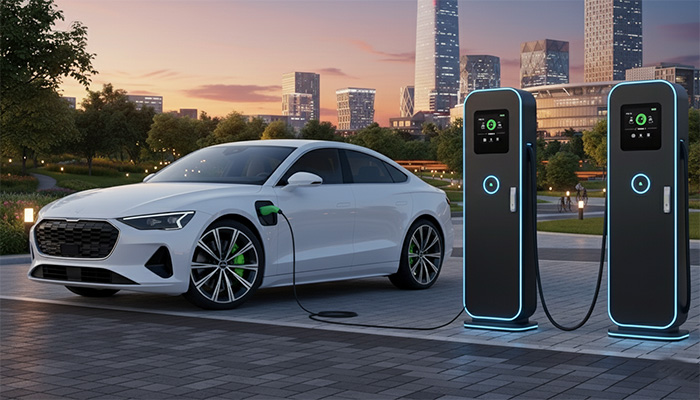Micro switches play a critical role in modern automotive electronic systems. They operate based on a unique snap-action mechanism and electronic signal transmission principles, enabling high-precision and high-reliability switching actions with minimal contact gaps under specified travel and force. As vehicles trend toward intelligence and miniaturization, micro switches have become essential components in various core systems, including safety, control, and comfort.

Core Applications of Automotive Micro Switches
1. Door Lock Systems
In door lock systems, the micro switch is key to detecting the closure status of the doors, hood, and trunk. It accurately identifies the two-stage locking status (half-latch and full-latch), reliably controlling interior lighting and safety alarms.
Given the harsh installation environment and the requisite for high reliability, this application often requires waterproof micro switch with a high IP rating for robust resistance against water and dust intrusion.
2. Seat Adjustment Systems
Within seat adjustment systems, micro switches precisely sense the seat’s position to enable electric adjustments for fore/aft movement, height, and tilt. Critically, they provide limit protection for the motors, preventing excessive driving force that could cause damage, and ensure position accuracy for memory functions.
3. Safety Restraint Systems
Micro switches serve an auxiliary function in safety restraint systems. They are primarily used for seat belt buckle status detection (confirming the occupant is buckled up) and assist in monitoring the status of the auxiliary airbag system, acting as a vital feedback component for occupant safety.
4. Wiper Systems
In wiper systems, micro switches control the wiper’s activation, speed, and mode selection. Their essential function is to precisely detect and control the wiper arm’s parking position, ensuring it stops accurately when deactivated and does not obstruct the driver’s vision.
5. Reversing Assistance Systems
Micro switches are utilized in reversing assistance systems to detect whether the shift lever has been engaged in reverse gear (R-gear). This precise signal is the prerequisite for initiating the reversing radar system and activating the rearview camera, thereby helping the driver avoid collisions.
Auxiliary Control and HMI Applications of Micro Switches
Beyond the core systems mentioned above, micro switches also play a crucial role in other control and auxiliary systems within the vehicle.
In complex driving control systems, micro switches provide indispensable feedback on position and status. For instance, in Shift-by-Wire (SBW) systems, they promptly confirm the driver’s gear selection signal, ensuring that control commands are accurately translated into mechanical execution. Similarly, in Electronic Parking Brake (EPB) systems, they precisely detect the operating state of the button or lever, serving as a critical link in converting driver intent into an electrical signal to ensure safe parking.
For the Human-Machine Interface (HMI), micro switches significantly enhance user experience and operational reliability through their short travel and clear tactile feedback characteristics. They are subtly integrated inside the headlamp/turn signal control stalks to enable precise triggering of turn and high-beam signals. Furthermore, micro switches are widely used in various vehicle auxiliary function buttons, such as glove compartment latches, fuel door releases, and tailgate buttons, ensuring reliable command execution with every press.
Micro Switches in Electric Vehicles
Micro switches are taking on an increasingly vital role in the emerging Electric Vehicle (EV) sector, with applications directly tied to vehicle energy efficiency and the operational safety of high-voltage systems:
-
Battery Thermal Management Systems: Micro switches are commonly used to monitor the precise position of cooling fluid valves or air dampers. They ensure that the flow direction and switching status of the cooling medium are accurately reported, which is crucial for maintaining the battery pack within its optimal operating temperature range.
-
High-Voltage Relay Monitoring: For high-voltage relays connected to the battery, micro switches often function as an Auxiliary Contact. These contacts operate independently of the main contacts, specifically reporting the true open or closed state of the main circuit to the vehicle control unit, which is essential for ensuring system isolation and safety.
-
Charging Lock and Interlock: In the charging plug locking mechanism, the micro switch acts as an essential safety interlock sensor. It detects whether the charging gun is fully inserted and securely locked. This signal is a critical prerequisite for initiating the charging process or releasing the vehicle’s anti-theft lock.
Related reading: Micro Switches in EV Charging Connectors
Conclusion
In summary, micro switches are fundamental components of modern automotive electronic control systems. Delivering the required high operational precision, exceptional durability, compact dimensions, and superior environmental protection features demands specialized expertise from the micro switch manufacturer. These robust components ensure vehicle safety, functional execution, and passenger comfort. From critical safety areas like door locks and restraint systems, to driving controls such as SBW and EPB, micro switches provide indispensable position and status feedback. Looking ahead, as the intelligence and electrification of vehicles continue to deepen, micro switches will maintain their decisive technological supporting role in meeting the demands for high integration and complex functionality.

